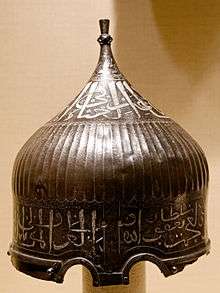Begzada
 | |
|
Shah : Emperor | |
|
| |
|
King : Sultan, Sultana, Padishah | |
| Royal Prince : Shahzada (Şehzade), Mirza | |
| Noble Prince : Sahibzada | |
| Nobleman: Nawab, Baig, Begzada | |
| Royal house : Damat, | |
| Governmental : Lala, Agha, Hazinedar |
Begzade (Kurdish), Beyzade (Turkic), and Begzadići (Slavic), Begzadi (female) are titles given within the Ottoman Empire to provisional governors and military generals who are decedents of noble households and occupy important positions within the empire.[1][2][3] The term Beyzade often appears in western accounts of the Ottoman Empire as superiors within the society, usually men who held a lot of authority.[4][5] In Eastern Europe, Balkans, Caucasus, and some parts of Anatolia and Iraqi Kurdistan the title Beyzade was given to Circassian princes who lead parts of the Ottoman conquest in these regions.[6][7][8][9][10]
Social status
The Begzade as a caste developed in Kurdistan among some of the chief tribes and householders such as those of the Jaffs Khoshnaws and the Berwaris.[11][12] 'Begzade formed the dominant class of the tribe or household. They did not intermarry with socially inferior tribespeople, however, a member of the Begzade could be part of the caste both by kinship ties to the ruling lineage and as one of their retainers.[13] Although regarded as Kurds, the Begzade come from an ethnically mixed background as most of them have Circassian origins.[14][15][16]
See also
Notes
References
- ↑ Ali H. Neyzi (1992). Beyzade-Paşazade: 1930-1990, Volume 2. Yanar Yayınları. Retrieved 27 October 2013.
- ↑ Özdemir Kaptan (1988). Beyoğlu: (Beyoğlu ve kısa geçmişi). Aybay Yayınları. Retrieved 27 October 2013.
- ↑ Atilla Dorsay (1991). Benim Beyoğlum. ağdaş Yayıncılık ve Basın Sanayii A.Ş. Retrieved 27 October 2013.
- ↑ Sir Slade, Adolphus (1833). Records of Travels in Turkey, Greece, &c: And of a Cruise in the Black Sea, with the Capitan Pasha, in the Years 1829, 1830, and 1831, Volume 2. E. L. Carey & A. Hart. p. 26.
- ↑ Wells, Florian Stone (2008). The Sword and the Shield of the Realm. Florian Stone Wells. p. 305. ISBN 0979957702.
- ↑
- ↑ Philliou, Christine M. (2010). Biography of an Empire: Governing Ottomans in an Age of Revolution. University of California Press. ISBN 0520947754.
- ↑ Cole, Juan Ricardo (1999). Colonialism and Revolution in the Middle East. American Univ in Cairo Press. ISBN 9774245180.
- ↑ Chatty, Dawn (2010). Displacement and Dispossession in the Modern Middle East. Cambridge University Press. ISBN 0521817927.
- ↑ Pamuk, Sevek (2000). A Monetary History of the Ottoman Empire. Cambridge University Press. ISBN 0521441978.
- ↑ Maarten Martinus van Bruinessen (1978). Agha, shaikh and state: on the social and political organization of Kurdistan. Rijksuniversiteit. p. 80. Retrieved 27 September 2012.
- ↑ Yalçın-Heckmann, Lale (1991). Tribe and kinship among the Kurds. Peter Lang Publishing. ISBN 3631427026.
- ↑ Tapper, Richard (2012-04-23). Tribe and State in Iran and Afghanistan. Routledge. p. 408. ISBN 9780415610568. Retrieved 27 September 2012.
- ↑ Maglaughlin, Kelly (2001). Kurdish Culture and Society: An Annotated Bibliography. Greenwood Publishing Group. ISBN 0313315434.
- ↑ Natho, Kadir (2009). Circassian History. Xlibris Corporation. ISBN 146531699X.
- ↑ Gingeras, Ryan (2009). Sorrowful Shores: Violence, Ethnicity, and the End of the Ottoman Empire 1912-1923. Oxford University Press. ISBN 9780191609794.